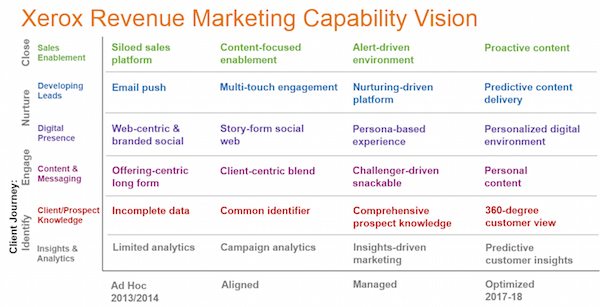Today’s Q&A is with Jeremie Moritz, the Global Digital Content & Media Manager at Pernod Ricard in Paris. Pernod Ricard is the company behind many of the world’s leading brands of distilled beverages, including Absolut, Beefeater, Chivas Regal, Glenlivet, Jameson, and Kahlúa, as well as major wineries such as Kenwood and Jacob’s Creek. Talk about iconic brands! Its history traces back to 1797, when Henri-Louis Pernod opened his first absinthe distillery in Switzerland.
Here’s a bit of insight into how they’re stirring marketing technology into the mix. (Thanks to Jeremy Epstein of Sprinklr, who connected us.)
1. Can you tell us a little about your background and your current role?
I started to build very simple websites when I was 14 and very early on worked in digital projects in parallel of my studies. I have 12 years of experience in various companies: FMCG, digital agencies, start-ups, and as a consultant.
I joined Pernod Ricard in 2012 as social media manager for the group. We launched our Digital Acceleration program quickly after that. I then was in charge of everything around content and media including partnerships, social media, search marketing, and also developing our own content and services platforms. I just started a new and exciting role as leader of our Digital Growth Program.
2. Can you tell us about the new initiative you’re leading, setting up a “Digital Growth Program” — what is it, and what does Pernod Ricard hope to achieve with it?
To put it simply, we want to foster business growth thanks to digital opportunities and figured out we need a specific program to push our projects faster, stronger, and at scale. We already have a lot of innovative projects using technology and digital media, but we struggle to go from experiments to full-scale products.
We already have a lot of innovative projects using technology and digital media, but we struggle to go from experiments to full-scale products.
On top, we do innovate a lot and with a clear process when it comes to our core products, spirits and wines, but building services and content platforms is newer. We need to support this by synchronizing our initiatives and applying new techniques which people call “growth hacking” — I would simply call this marketing common sense and fast execution.
3. As marketing has engaged more deeply in technology as an integral part of its mission, how has the relationship between marketing and IT evolved?
It has not evolved but revolved.
The lines are getting blurrier since IT products are now available at everybody’s fingertips with the rise of software-as-a-service. I also see a new breed of marketers who are not afraid of technology.
When you see 15 year-old bloggers who use MailChimp segmentation and automation tools and get top-notch SEO rankings thanks to WordPress plugins, you start to question the way marketing and IT are divided. Clearly the separation is not going to stand for long. We need cross-functional teams of experts put together depending on the projects — period. If you look at e-commerce, it perfectly shows the set of skills and people you need to run such projects: marketing, sales, IT, support, design, and so on.
When you see 15 year-old bloggers who use MailChimp segmentation and automation tools and get top-notch SEO rankings thanks to WordPress plugins, you start to question the way marketing and IT are divided.
It’s not an easy change, and you still have foundational IT, but all the rest should blend in business teams.
4. At a high level, can you describe the components of your marketing technology stack? Did you go with a suite from a single vendor, or more best-of-breed? Why?
We did not go for a unique suite from the same vendor. Putting all our eggs in the same basket is too dangerous. We see the interest from the vendors point-of-view, but first we need to keep up with the evolving products and, more importantly, we have to build a digital architecture where we can replace one component without impacting — at least not too much — the others.
We have to build a digital architecture where we can replace one component without impacting — at least not too much — the others.
Agility in your architecture is key, especially for your databases. On our side, we work with the big ones like Salesforce, Oracle, and Sprinklr, but also some smaller partners. A key element in our decisions is that each platform should be open, in and out, to plug into the rest of our ecosystem.
5. What are the challenges you’ve seen in spreading adoption of these technologies more widely across marketing? How have you addressed them?
I see two main challenges, whatever the technology you’re trying to implement: people and context.
For builders of tech platforms, getting the context of each company, its organization, the way its people work together, is really hard unless you spent the right amount of time with the different teams. I sometimes wish our new partners would push back the kick-off date to make sure they talked with the right people and defined the right structure and processes to fit our needs. It’s so new that you rely a lot on them, and sometimes we do not challenge enough their pre-built plan.
Because in the end, technology’s bottleneck is people. Any platform you work with is only going to give you the first 10% to deliver your objective. The remaining 90% are the people driving this platform and the project behind it. If you don’t involve people in the brief, the choice, and the enablement — and empower them to make it work for their local business — you’ll go nowhere.
Any platform you work with is only going to give you the first 10% to deliver your objective. The remaining 90% are the people.
It’s a journey but the more you integrate this, the better results you get. It’s really change management.
6. How do you see the relationships between brands and agencies evolving in this new environment? How do you decide what should be done by agencies vs. done in-house?
The relationship is clearly shifting, with brands moving faster than agencies from my point of view. More and more brands understand the need to change the way they work. Not to cut agencies from the equation, but to take the best of each world.
Most agencies have tried to create an integrated model, where they become the brand’s Swiss Army knife. But it just doesn’t work like this because collaborations can come from many different sources: in-housing some positions, using freelancers at will, working with specialized teams, etc.
We still need agencies, but the definition of an agency has clearly evolved. Brands want more modularity, more choice, and more creativity. I see more value today in the people who connect us to the right people or agencies than in agencies themselves. It’s not an insult, but it’s just that finding the right fit is the hardest part. There is no scarcity of talent, but you need partners, not cold contractors.
I think the in-housing of some positions like community management, some basic design, and development, is going to increase, because it just makes sense.
Finally, I think the in-housing of some positions like community management, some basic design, and development, is going to increase, because it just makes sense financially and simplifies ways of working.
Merci, Jeremie!
Final reminder: ticket prices for MarTech Europe go up on August 1. Don’t miss this opportunity to attend the most in-depth conference on the intersection of modern marketing, technology, and management this fall at the best possible rate.




Great Q&A! I love the part about not putting all the eggs in one basket and it’s something many organizations struggle with (one one hand, having complete integration makes it easier to know what’s possible out of the box, how data transfers, etc. and on the other hand, new tools will give you greater flexibility and power features that the all-in-one can’t deliver). I think in the end it really depends on the organization’s vision for growth (and their available budget) to help determine the level of “strategic technology fragmentation” they’re willing to take on in order to best out the competition.
Thanks and agree Jeff! The easy path is to go with 1 integrated solution for everything but if you really care you need specialists who undersand each topic. We live in a more and more complex world where database management is different than CRM and different than Social Media Management. All these are linked so they need to talk but you need experts to articulate all this and get full return on objectives. Money is a parameter but I think the same applies at each budget levels as you get offers from small to big size companies.
“We already have a lot of innovative projects using technology and digital media, but we struggle to go from experiments to full-scale products.”
I think that’s a good thing. Most experiments should/will result in failure or at least that’s how it is in a science lab and in a mathematician’s proofs sketchbook.
The struggle you describe is the innovation to me.